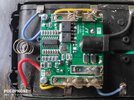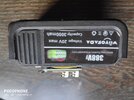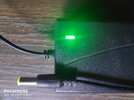Hi, I would like to ask for your advice and opinion regarding a 18V Li Ion battery that I have. it was purchased from Aliexpress along with a clone of Makita impact drill. it came as a set of three - the drill, the battery and it's charger. I was only able to charge the battery twice and then it went dead. when I connect the charger's plug to the mains, it's led is immediate lights green (as can be seen in the attached pic), even without being connected to the battery's charging socket. as I know, it should be red until the battery is fully charged and then turn to green. could it be that the problem lies with the charger that doesn't provides current to charge the battery? I've measured the voltage on the socket - it's 21.58V and the voltage on the +B and -B battery terminals is 1.71V. on the battery's top there is a JY-MT-5S-V1.0 pc board, which I guess controls the charging. if my assumption is right, and the charger doesn't provide the current to charge, is it possible to connect an "external" power supply (with the correct values, of course), even if only to assure the assumption that the problem is with the charger, and see if it charges the battery? I'll appreciate any idea.




